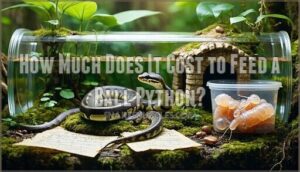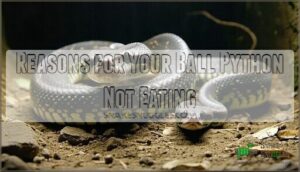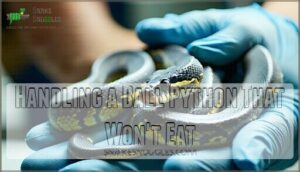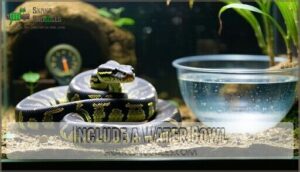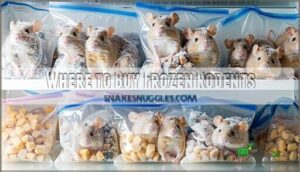This site is supported by our readers. We may earn a commission, at no cost to you, if you purchase through links.
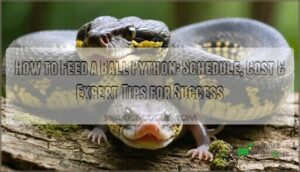
Hatchlings eat every 5–7 days, while adults eat every 10–14 days.
Frozen-thawed rodents are ideal—they’re safer and more convenient than live prey.
Expect to spend $2–$12 per meal, depending on the size and type of prey.
Keep a consistent feeding schedule and avoid handling your snake for 48 hours after meals to prevent regurgitation.
If picky eating strikes, check habitat temperatures and avoid feeding during shedding.
Curious about live versus frozen debate or coaxing picky eaters?
There’s more to explore on those topics.
Table Of Contents
- Key Takeaways
- What to Feed Ball Pythons
- Ball Python Feeding Schedule
- How Much Does It Cost to Feed a Ball Python?
- Live Vs Frozen Food
- Feeding Tips to Get Your Ball Python to Eat
- Reasons for Your Ball Python Not Eating
- Handling a Ball Python That Won’t Eat
- Should You Feed in The Enclosure?
- Include a Water Bowl
- Where to Buy Frozen Rodents
- Frequently Asked Questions (FAQs)
- Do ball pythons need a feeding chart?
- How much does it cost to feed a ball python?
- What factors influence a ball python feeding schedule?
- Do ball pythons eat a lot?
- How often should you feed a ball python?
- How do you get a ball python to eat?
- What is the best feeding schedule for ball pythons?
- Can I hold my ball python 24 hours after feeding?
- Should I feed my ball python at night or during the day?
- Is it safe for me to handle my ball python after feeding or does that stress them out?
- Conclusion
Key Takeaways
- Feed your ball python frozen-thawed rodents that match 1 to 1.25 times the snake’s midsection diameter for safe and healthy feeding.
- Stick to a feeding schedule: hatchlings eat every 5–7 days, juveniles weekly, and adults every 10–14 days to avoid overfeeding.
- Expect to spend $5–10 per week or $100–150 annually on feeding, with bulk buying reducing costs.
- Avoid handling your snake for 48 hours after meals to prevent regurgitation, and feed at night to match its natural hunting behavior.
What to Feed Ball Pythons
Your ball python’s diet consists primarily of appropriately sized frozen-thawed mice or rats, which provide complete nutrition and eliminate the safety risks associated with live prey.
Appropriately sized frozen-thawed rodents are the safest and most nutritious choice for successfully feeding your ball python.
You’ll need to select prey items that match 1 to 1.25 times your snake’s midsection diameter, starting with pinky mice for juveniles and progressing to adult rats as your python grows.
Correct Ball Python Food Size
Getting the prey size right is like finding the perfect fit—your ball python’s meal should match their midsection’s widest point.
Prey girth that’s too large creates overfeeding risks, leading to dangerous regurgitation.
Start hatchlings on pinky mice, then gradually increase to fuzzies and hoppers as they grow.
Understanding appropriate rodent dimensions is essential for successful feeding and prevents underfeeding signs while supporting healthy development throughout their ball python diet journey.
When is The Best Time to Feed
Ball pythons are crepuscular hunters, meaning they’re most active during twilight hours.
Feed your snake during evening or early morning when their activity levels naturally peak. This mimics their wild behavior and improves feeding response.
Establish a consistent routine—your ball python’s digestion timing works best with predictable schedules. Avoid feeding during shedding periods when snakes typically refuse food, as this is crucial for their health and feeding response.
Ball Python Feeding Schedule
Establishing the right feeding schedule for your ball python depends on age, size, and growth stage, with younger snakes requiring more frequent meals than adults.
You’ll need to adjust feeding frequency from every 5-7 days for hatchlings to every 2-3 weeks for mature adults, monitoring your snake’s body condition to maintain ideal health.
Feeding Baby Ball Pythons
Young ball pythons are feeding machines during their first year.
You’ll need to offer meals every 5-7 days to fuel their rapid growth. Hatchling feeding size should match your snake’s midsection diameter—start with pinky mice and gradually increase prey size as they develop.
Monitor their body condition closely; visible spine ridges indicate underfeeding while stretched scales suggest overfeeding. This feeding frequency supports healthy development, though some babies may refuse meals during shedding periods or stress, which can be a sign of rapid growth.
Feeding Adult Ball Pythons
Adult ball pythons eat every 10-14 days, requiring larger prey than juveniles. Your snake’s adult prey size should match its thickest body section—typically adult mice or small rats.
This reduced feeding frequency prevents obesity while maintaining proper nutrition. Monitor your python’s weight regularly, as overfeeding creates health problems.
Some adults may refuse food seasonally or during breeding periods. Adjust your feeding schedule based on your snake’s body condition, activity level, and individual metabolism for optimal health.
It’s vital to choose prey that’s 1 to 1.25 times the snake’s width, ensuring a proper fit.
How Much Does It Cost to Feed a Ball Python?
Feeding your ball python won’t break the bank, with annual costs ranging from $100 to $150.
Your snake’s age and size directly impact these expenses, as baby pythons eat smaller prey more frequently while adults consume larger rodents less often.
Here’s what drives your ball python cost breakdown:
- Feeder mice pricing – Individual frozen mice cost $0.50 to $3 depending on size, with adult mice averaging $2-3 each
- Bulk buying savings – Purchasing 50-count boxes reduces per-unit costs substantially compared to single purchases
- Long-term budgeting – Adults eating weekly cost approximately $100-150 annually, while juveniles may cost slightly more due to frequent feeding
Rodent price factors include supplier choice and prey size.
Alternative prey costs remain minimal since ball pythons thrive on a consistent rodent diet.
Smart purchasing from reptile supply companies or local breeders maximizes your breeding food costs efficiency.
Live Vs Frozen Food
Throughout decades of ball python care, the debate between live vs frozen food has sparked countless discussions among reptile enthusiasts.
While both options can sustain your snake, frozen prey emerges as the clear winner for most situations.
| Aspect | Live Prey | Frozen Prey |
|---|---|---|
| Safety | Bite/scratch injuries possible | Zero injury risk |
| Parasites | Higher parasite transmission | Eliminated during freezing |
| Convenience | Requires immediate feeding | Store for months |
| Cost | Premium pricing | Budget-friendly |
| Ethics | Causes prey suffering | Humane pre-killed option |
Frozen nutrition loss remains minimal when you follow proper thawing best practices.
Switching methods from live to frozen typically succeeds with patience and proper presentation techniques.
Live prey risks simply outweigh any perceived benefits, making frozen mice the safer choice for responsible ball python ownership, due to the humane pre-killed option and zero injury risk.
Feeding Tips to Get Your Ball Python to Eat
Frozen food offers convenience and safety, but sometimes your ball python needs extra encouragement.
Getting reluctant eaters back on track requires patience and the right approach.
Here are proven feeding tips to stimulate your snake’s appetite:
- Heat the prey’s head – Warm it to 95-100°F using hot water to enhance scent detection
- Try scenting prey – Rub mouse fur on the head or use different rodent species
- Use braining rodents – Expose brain matter by making a small incision to release stronger odors
- Offer multiple prey – Present smaller items together for variety
- Perfect your timing – Feed during evening hours when ball pythons are naturally active
Reasons for Your Ball Python Not Eating
Ball pythons naturally refuse food for several biological and environmental reasons, which can concern new owners but often reflects normal behavior patterns.
Understanding these common triggers will help you identify whether your snake’s feeding refusal requires intervention or simply patience while natural cycles run their course.
Temperature Fluctuation
Temperature swings can shut down your ball python’s appetite faster than you’d expect.
When your snake’s environment gets too hot or cold, it disrupts their natural feeding drive and digestion process.
| Temperature Factor | Ideal Range | Impact on Feeding |
|---|---|---|
| Basking Temperature | 88-92°F | Essential for digestion |
| Nighttime Drop | 78-80°F | Mimics natural cycle |
| Heating Methods | Under-tank heaters | Maintains thermal gradient |
| Thermal Gradient | 10-15°F difference | Allows thermoregulation |
| Seasonal Changes | Consistent year-round | Prevents feeding strikes |
Maintain steady habitat temperature with quality thermostats and heating methods for successful ball python feeding.
Shedding and Molting
Ball pythons naturally refuse food during shedding cycles, typically occurring every 4-6 weeks. Your snake’s cloudy eyes and dull scales signal an upcoming shed. Don’t panic if they fast for 2-3 weeks during this process.
- Monitor humidity levels at 60-70% to prevent stuck shed complications
- Watch for milky eyes and ashy skin indicating shedding signs
- Avoid handling during molting to reduce stress and feeding refusal
To ensure a smooth shedding process, it’s crucial to maintain proper care, including watching for signs like stuck shed complications.
Stress and Anxiety
Stress can make feeding ball pythons tricky. Enclosure stressors, like improper lighting or loud noises, lead to feeding strikes.
Handling anxiety worsens matters in non-acclimated snakes. Create a secure feeding environment by adding hides and environmental enrichment. Minimize handling during meals and follow a consistent feeding schedule.
Use this quick table for solutions:
| Issue | Cause | Solution |
|---|---|---|
| Enclosure stressors | Loud noises, poor setup | Add hides, adjust lighting |
| Handling anxiety | Overhandling | Limit interactions |
| Feeding strikes | Fear, inconsistency | Steady schedule, secure setup |
Handling a Ball Python That Won’t Eat
Sometimes ball pythons just won’t eat, and pinpointing why can feel tricky.
Start by double-checking temperature and humidity—they’re essential for proper appetite. If that doesn’t help, schedule a visit with an exotic vet.
They’ll check for underlying illness, parasites, or any physical issues affecting appetite loss. While waiting, try scenting prey with warm water or a different animal scent (like quail).
Appetite stimulants or smaller prey might encourage eating too. Minor habitat tweaks, like adding environmental enrichment or extra hides, often reduce stress.
Consider that seasonal fasting patterns can also play a role in reduced appetite. Stick to your feeding schedule, but don’t push the snake.
A vet-guided plan for the ball python diet and consistent care usually solves feeding challenges. Patience and observation go a long way toward success.
Should You Feed in The Enclosure?
Feeding your ball python in its enclosure is often the best option.
It reduces stress by allowing them to eat in a familiar, secure space.
Still, you need to address hygiene and safety concerns to avoid issues like prey remnants or substrate ingestion.
Trust this feeding process—it mirrors their natural ambush predator instincts.
But are there cases where alternatives might work better?
Here’s when feeding inside the enclosure makes sense:
- Stress Reduction: Moving the snake for meals may increase anxiety or disrupt their feeding schedule.
- Safety Risks: Outside feeding can lead to dropped food or accidental bites.
- Enclosure Association: Feeding where they reside builds routine and helps with consistent ball python care.
Prioritize what keeps your snake happiest, healthiest, and thriving.
Some keepers prefer a different setup to avoid substrate ingestion risks.
Include a Water Bowl
After feeding your ball python, don’t underestimate the importance of hydration.
A sturdy water bowl, large enough for your snake to soak in, should always sit on the enclosure’s cool side.
Check the water daily and clean the bowl every two to three days to prevent bacteria buildup—use a mild bleach solution if it’s soiled.
Tap water is safer than distilled water, which can lead to dehydration.
For juveniles, refill their water daily; for adults, twice a week works fine.
A filled water bowl supports hydration and also helps maintain enclosure humidity, aiding healthy shedding.
Watch for signs of dehydration, like wrinkled skin or refusal to eat.
Consider browsing for snake water bowl options to find the best fit for your pet.
Where to Buy Frozen Rodents
If you’ve got your ball python’s water bowl sorted, the next step is sourcing frozen rodents.
Thankfully, there are plenty of reliable options out there.
- Online retailers like Layne Labs and Perfect Prey offer home delivery with various sizes, from pinkies to adult rats.
- Visit local pet stores, especially reptile-focused ones, as chains often have limited choices.
- Check reptile expos for bulk buying deals on frozen mice for snakes.
- Connect with local breeders or rodent farms, which can offer fresh, affordable frozen feeders.
Many suppliers offer options to buy feeder rodents online.
Always verify the rodents are humanely euthanized, properly frozen, and parasite-free.
With a trusted source, feeding becomes safe, simple, and stress-free—for both you and your python.
Frequently Asked Questions (FAQs)
Do ball pythons need a feeding chart?
Picture a well-fed, thriving ball python.
A feeding chart isn’t mandatory, but it’s a lifesaver for tracking meals, prey sizes, and schedules.
It helps you guarantee balanced feeding, avoiding both underfeeding and overfeeding.
How much does it cost to feed a ball python?
You’ll spend about $5–10 per week for frozen mice or rats to feed a ball python.
Costs vary by prey size and snake age, with hatchlings eating less and mature pythons consuming larger, pricier prey.
What factors influence a ball python feeding schedule?
Think of a ball python’s feeding schedule as a dance with nature.
Age, size, metabolism, and life stage dictate timing.
Younger snakes eat more often, while adults space meals further apart to prevent obesity and stress.
Do ball pythons eat a lot?
Ball pythons don’t eat excessively.
Their meals depend on size and age, typically every 7 to 14 days.
Juveniles eat more often than adults.
Overfeeding can cause obesity, so portion and frequency matter.
How often should you feed a ball python?
Feed hatchlings every 5-7 days, juveniles weekly, and adults every 2-3 weeks.
Tailor the schedule to your python’s age, size, and metabolism.
Avoid overfeeding; it’s like giving dessert before dinner—a bad idea!
How do you get a ball python to eat?
Offer a room-temperature, thawed rodent using tongs near your ball python’s head.
Feed at night when it’s active. If it’s hesitant, gently wiggle the prey.
Make certain its environment feels safe and stress-free.
What is the best feeding schedule for ball pythons?
Imagine feeding as balancing a delicate dance. Hatchlings eat every 5–7 days, juveniles weekly, and adults bi-weekly or every 2–3 weeks. Match prey size to midsection girth, and never rush digestion.
Can I hold my ball python 24 hours after feeding?
Waiting 48 hours after feeding is wiser.
Ball pythons need time to digest; handling too soon risks regurgitation.
Think of it like post-Thanksgiving – no one wants activities right after a big meal!
Should I feed my ball python at night or during the day?
When the sun dips low, that’s when your ball python’s instincts kick in.
Feeding at night mimics their natural hunting hours, boosting their appetite and reducing stress.
Stick to dusk or twilight for best results.
Is it safe for me to handle my ball python after feeding or does that stress them out?
It’s best to avoid handling your ball python for at least 48 hours after feeding.
Handling too soon can stress them out and even cause regurgitation.
Let them digest peacefully to stay healthy.
Conclusion
Feeding ball pythons requires patience, precision, and a proper plan.
Stick to a schedule that suits your snake’s age, size, and feeding habits. Balance cost and convenience by choosing frozen-thawed rodents, which are safer and more reliable than live prey.
Monitor habitat conditions to prevent picky eating, stress, or regurgitation. Remember, regular meals and minimal handling after feeding promote a healthy, happy snake.
Master this process, and your ball python will thrive seamlessly in your care, with proper plan in place.


